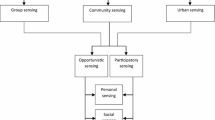Abstract
SigSense, a mobile crowdsensing-based geospatial video game, has been proposed to survey live signal strength using smartphones.It provides attractive incentives to the contributers. Live data collected as a survey through this game is used to recommend locations for installing the base stations to improve the signal quality using the Greedy Algorithm. A large plot of land is considered a large matrix. We have recursively divided the land into smaller submatrices. Then signal strength survey of each submatrix is performed through Mobile Crowd Sensing using SigSense. The recommendation system advices the locations for installing the network base stations for improving signal strength. An incentive is provided to a player based on the game's rules, making it a win–win situation for both the player and the network service provider. The unique feature of this game is that it can be played even in an area where is low mobile network coverage. A player’s details are hidden from other players through unique masked ids and mixed reality.












Similar content being viewed by others
References
Pandey, S. R., Tran, N. H., Bennis, M., Tun, Y. K., Manzoor, A., & Hong, C. S. (2020). A crowdsourcing framework for on-device federated learning. IEEE Transactions on Wireless Communications, 19(5), 3241–3256.
Li, Z., Liu, H., & Wang, R. (2019). Service benefit aware multi-task assignment strategy for mobile crowd sensing. Sensors, 19(21), 4666.
Saadatmand, S., & Kanhere, S. S. (2019). MRA: A modified reverse auction based framework for incentive mechanisms in mobile crowdsensing systems. Computer Communications, 145, 137–145.
De, D. (2019). Mobile cloud computing: Architectures, algorithms and applications. Chapman and Hall/CRC.
Capponi, A., Fiandrino, C., Kantarci, B., Foschini, L., Kliazovich, D., & Bouvry, P. (2019). A survey on mobile crowdsensing systems: Challenges, solutions, and opportunities. IEEE Communications Surveys & Tutorials, 21(3), 2419–2465.
Koukoumidis, E., Peh, L. S., & Martonosi, M. R. (2011). Signalguru: Leveraging mobile phones for collaborative traffic signal schedule advisory. In Proceedings of the 9th international conference on mobile systems, applications, and services (pp. 127–140).
Costa, C., Laoudias, C., Zeinalipour-Yazti, D., & Gunopulos, D. (2011). SmartTrace: Finding similar trajectories in smartphone networks without disclosing the traces. In 2011 IEEE 27th international conference on data engineering (pp. 1288–1291). IEEE.
Wu, C., Yang, Z., & Liu, Y. (2014). Smartphones based crowdsourcing for indoor localization. IEEE Transactions on Mobile Computing, 14(2), 444–457.
Thiagarajan, A., Ravindranath, L., LaCurts, K., Madden, S., Balakrishnan, H., Toledo, S., & Eriksson, J. (2009). Vtrack: Accurate, energy-aware road traffic delay estimation using mobile phones. In Proceedings of the 7th ACM conference on embedded networked sensor systems (pp. 85–98).
Yang, M., Zhu, T., Liang, K., Zhou, W., & Deng, R. H. (2019). A blockchain-based location privacy-preserving crowdsensing system. Future Generation Computer Systems, 94, 408–418.
Zhang, X., Yang, Z., Sun, W., Liu, Y., Tang, S., Xing, K., & Mao, X. (2015). Incentives for mobile crowd sensing: A survey. IEEE Communications Surveys & Tutorials, 18(1), 54–67.
Tao, D., Wu, T. Y., Zhu, S., & Guizani, M. (2020). Privacy protection-based incentive mechanism for Mobile Crowdsensing. Computer Communications, 156, 201–210.
Bekele, M. K., Pierdicca, R., Frontoni, E., Malinverni, E. S., & Gain, J. (2018). A survey of augmented, virtual, and mixed reality for cultural heritage. Journal on Computing and Cultural Heritage (JOCCH), 11(2), 1–36.
Flavián, C., Ibáñez-Sánchez, S., & Orús, C. (2019). The impact of virtual, augmented and mixed reality technologies on the customer experience. Journal of Business Research, 100, 547–560.
Broll, G., & Benford, S. (2005). Seamful design for location-based mobile games. In International conference on entertainment computing (pp. 155–166). Springer, Berlin, Heidelberg.
Barkhuus, L., Chalmers, M., Tennent, P., Hall, M., Bell, M., Sherwood, S., & Brown, B. (2005). Picking pockets on the lawn: the development of tactics and strategies in a mobile game. In International conference on ubiquitous computing (pp. 358–374). Springer, Berlin, Heidelberg.
Drozd, A., Benford, S., Tandavanitj, N., Wright, M., & Chamberlain, A. (2006). Hitchers: Designing for cellular positioning. In International conference on ubiquitous computing (pp. 279–296). Springer, Berlin, Heidelberg.
Bell, M., Reeves, S., Brown, B., Sherwood, S., MacMillan, D., Ferguson, J., & Chalmers, M. (2009). Eyespy: Supporting navigation through play. In Proceedings of the SIGCHI conference on human factors in computing systems (pp. 123–132).
Khan, F., Rehman, A. U., Zheng, J., Jan, M. A., & Alam, M. (2019). Mobile crowdsensing: A survey on privacy-preservation, task management, assignment models, and incentives mechanisms. Future Generation Computer Systems, 100, 456–472.
Ongbwa, B. A. E., Kora, A. D., Mbemba, H., & Amelete, S. (2018). Objective approach of 3G/4G networks indoor RF coverage assessment. In 2018 4th International conference on frontiers of signal processing (ICFSP) (pp. 17–23). IEEE.
Trogh, J., Plets, D., Surewaard, E., Spiessens, M., Versichele, M., Martens, L., & Joseph, W. (2019). Outdoor location tracking of mobile devices in cellular networks. EURASIP Journal on Wireless Communications and Networking, 2019(1), 1–18.
Prasetya, D. A., Nguyen, P. T., Faizullin, R., Iswanto, I., & Armay, E. F. (2020). Resolving the shortest path problem using the haversine algorithm. Journal of Critical Reviews, 7(1), 62–64.
Geetha, K., & Kannan, A. (2019). An efficient information system for providing location based services in network environments. Wireless Personal Communications, 109(4), 2377–2398.
Wei, X., Hong, H., Daniel, D. Z., & Wei, W. (2017). Emergency event web information acquisition using crowd web sensors. Wireless Personal Communications, 95(3), 2393–2411.
Author information
Authors and Affiliations
Corresponding author
Additional information
Publisher's Note
Springer Nature remains neutral with regard to jurisdictional claims in published maps and institutional affiliations.
Rights and permissions
About this article
Cite this article
Bhattacharya, A., De, D. SigSense: Mobile Crowdsensing Based Incentive Aware Geospatial Signal Monitoring for Base Station Installation Recommendation Using Mixed Reality Game. Wireless Pers Commun 123, 2863–2894 (2022). https://doi.org/10.1007/s11277-021-09267-5
Accepted:
Published:
Issue Date:
DOI: https://doi.org/10.1007/s11277-021-09267-5




